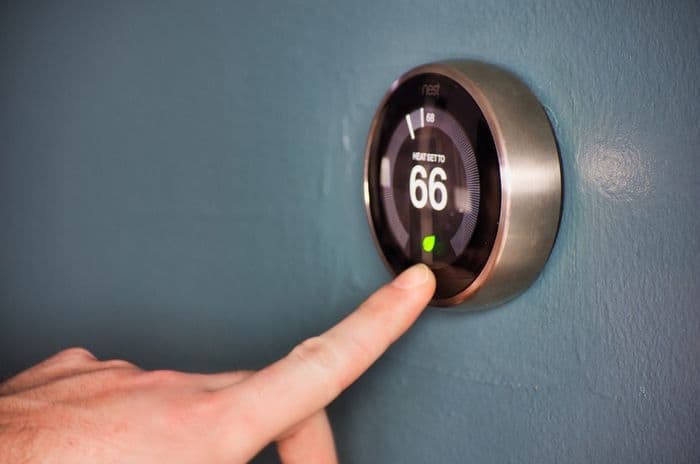Google's latest thermostat does what it says on the tin - it learns. After initially monitoring your behaviour, the thermostat programs itself to create a weekly temperature schedule.
It'll also take into consideration the outside temperature and how quickly your home heats up, and use the information to turn itself on in good time to reach a target temperature.
As well as being very clever, the Nest Learning Thermostat also looks good in the home. The pleasingly minimalist design is housed in a metal surround that comes in a choice of four colours.

The only negative - if you could call it that - is that the app is so packed with features that it felt a little confusing.
Price
You can buy the Nest Learning thermostat from Amazon for £185.
In both cases, you get the thermostat itself and the Nest Heat Link - a box that connects to your boiler and communicates with the thermostat.
You don't need to get a hub as the thermostat itself works as a hub. However, if you do have a hub like the Echo Show or Google Nest hub, then you'll still be able to control the thermostat with them.
What you do need is to pay for is an engineer to come and fit the Heat Link. As a rough guide, you can expect to pay around £80 for installation.
Nest doesn't have its own dedicated installation engineers, but you can use the search tool on its website to find independent local electrical fitters.
Like virtually all smart thermostats, the Nest Learning device is touted as being able to save you money.
According to Google estimates, UK customers saved between 8.4% and 16.5% on their energy bills using the Nest Learning thermostat.
However, looking at the background figures, we see these figures are based on the assumption that before switching to a smart thermostat, homeowners were keeping their homes at 20C during the day.
Based on this, the only people who are really going to significantly save money by installing a Nest Learning thermostat - or any smart thermostat for that matter - are those who basically ignore their current thermostat and leave the house warm even when they're at work.
While alternating the temperature of your home is a good way of reducing energy consumption, the best way of cutting the cost of your energy bills is to regularly change suppliers - it can save you hundreds of pounds a year. Using an online comparison tool will help you find the best price.
Usability
The thermostat lights up when you walk into the room, showing you the temperature, weather or time. The new display means you can read the information easily from anywhere in a normal-sized room.
Pressing the display and turning the ring shows a summary of what your thermostat is up to and allows you access to Settings, Energy History or your schedule.
You can control the temperature by simply turning the dial, which makes a satisfying clicking noise that is actually speaker-generated.
If anything goes wrong with the system, the Heat Link next to the boiler has a button that can be pressed to reset everything.
While manual control is all well and good, the app is where the fun really happens.
The Nest app - which is available for iOS and Android - can be used to control your heating (and hot water if you have a seperate water tank) from anywhere in the world, provided that you have an internet connection.
The first thing we like about the app is that it has two-factor authentication - the thought of hackers interfering with the central heating isn't a particularly appealing one.
We also like that it's easy to see how much energy we've used - either by the day or over the course of a month. The Energy History and Home Report enables the identification of high-energy consumption periods, and gives you the opportunity to address them.
Incidentally, the thermostat itself tries to help you reduce your consumption with the leaf icon, which appears if you lower the temperature of your home. Whether the reward of a leaf appearing is enough to influence anyone by itself is debatable.
Anyway, back to the app. Instead of programming a schedule with 'on' and 'off', you tell the app what temperature you'd like your home to be when you're in it, and a low temperature for when you're not.
The Nest then automatically creates a schedule based on your initial behaviour when the system is installed, taking into account times when you've manually adjusted the heating.
As you might expect, this isn't perfect and you will find yourself manually changing the temperature from time to time.
The Auto Away feature works well, using a combination of your phone's GPS and sensors in the thermostat to work out whether anyone's home and turning the heating off accordingly. You can add family members' phones so that they don't find themselves sitting in a rapidly cooling house whenever you leave.
If you have a separate hot water tank, you can create a hot water schedule in the app. You don't have to remember to turn off the hot water if you're away from home for a few days, as the Nest Learning Thermostat will do it for you.
Overall, the app is well-designed, with some nice touches like the background changing according to the local weather.
Compatibility
The Nest Learning thermostat works with most central heating systems. If you want to find out whether your system is compatible, the Nest website has an online tool that will tell you.
It's also worth considering the compatibility of your other smart devices. The thermostat supports Google Home, as well as Amazon Alexa. However, Apple HomeKit users will be disappointed that the Nest Learning app won't work with Siri.
Accessories
If you don't want the thermostat mounted on the wall, you'll need to pay an additional £35 for a stand to sit it on.
Other than the stand, the thermostat is a little lacking in associated accessories. Nest doesn't yet have its own range of smart thermostatic radiator valves, which is a little disappointing as this limits control over the heating of individual rooms.
Of course, there are a range of other smart Nest products that you can integrate into a smart home. Devices like smart cameras and smart lightbulbs can work together with the nest Learning thermostat - for example, you could have the lights turn off, and the security camera turn on, when the thermostat detects that nobody is home.
Summary
The Nest Learning thermostat is a great device, being both good-looking and smart. We like that it learns, even if it isn't perfect. Having previously been mildly addicted to turning the thermostat up and down, it's nice to have AI involved and anticipating some of our heating needs.
The app is nice to use, though playing around with the dozens of settings can absorb significant amounts of your time if you let it.
It's a shame that the device won't integrate with Siri, but Apple Home Kit users will no doubt already be used to avoiding Nest products.









Comments